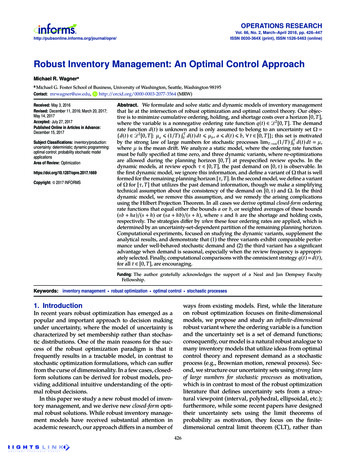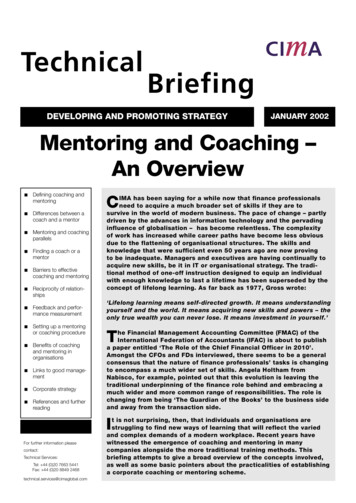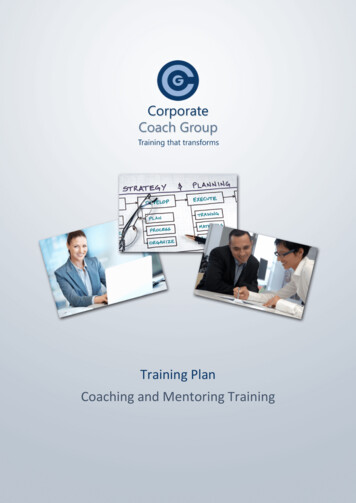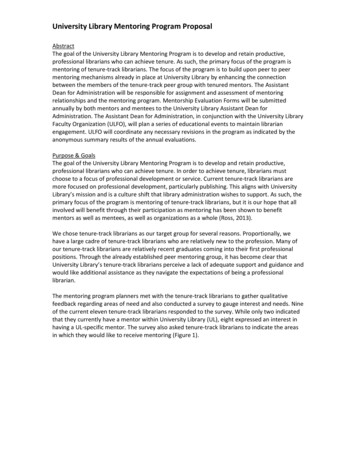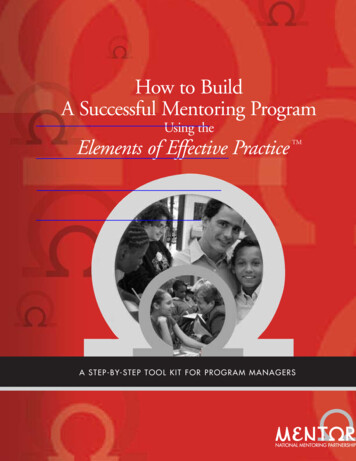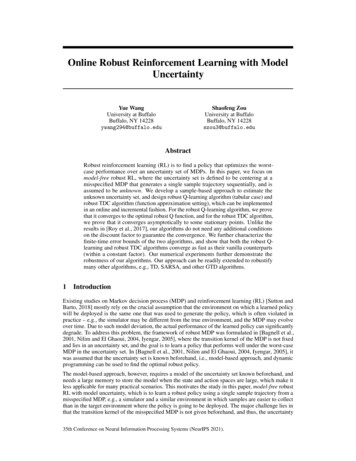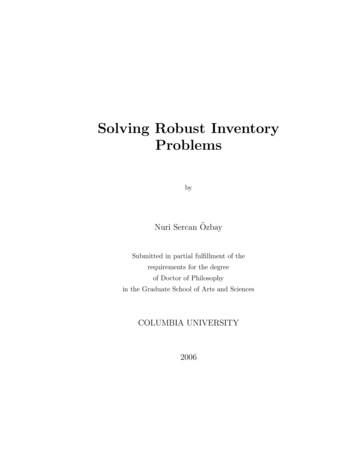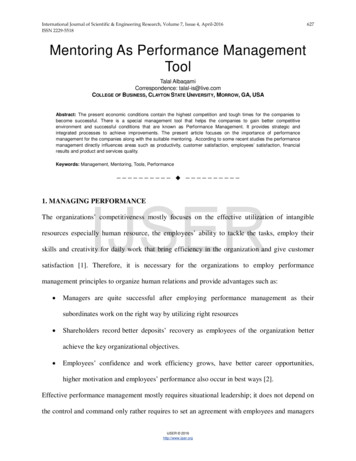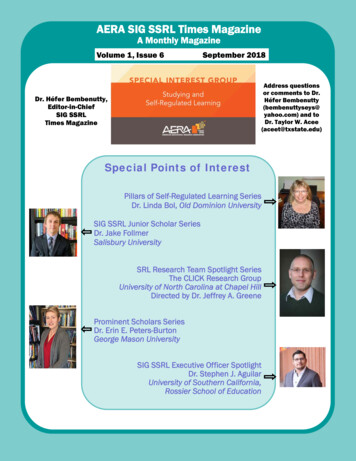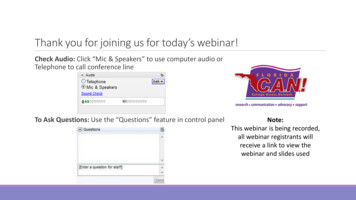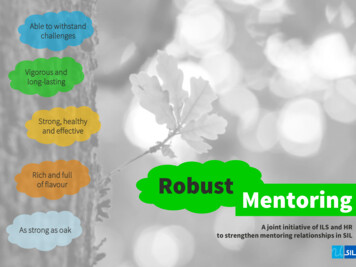
Transcription
Able to withstandchallengesVigorous andlong-lastingStrong, healthyand effectiveRich and fullof flavourAs strong as oakRobustMentoringA joint initiative of ILS and HRto strengthen mentoring relationships in SIL Duarte, Inc. 20141
ForewordDr Michel KenmogneExecutive Director I am delighted to commend to you the RobustMentoring Initiative described in this booklet,a collaborative effort from InternationalLanguage Services and Human Resourcesdepartments. It aims to foster a learningenvironment wherein everyone can thrive andachieve their full potential in serving,irrespective of their domain of contribution.Several realities urge us to intentionallypursue a culture of sharing knowledgethrough mentoring. Within the fabric of the globalsociety, traditional places of learning, suchas the family and educational institutions,have undergone much disruption, and thepace of change is fast. Life-long learning isnon-negotiable. Hence robust mentoringmust become a key organisational value. The sociological composition of ourworkforce indicates that the bulk of ourexpertise lies in a generation of pioneering,self-made individuals that will soon 2020 SIL Internationalphase out. By committing to anorganisational culture of mentoring, we willpreserve and transmit expertise acrossgenerations, and promote organisationallearning, thereby stewarding our valuableresources. In today’s volatile environment,relationships become shallow. Yet, we werecreated as relational people who thrive incommunity. We need to find ways to pursuethe pattern of ministry set by Jesus himself,who nurtured key relationships with a few,thereby extending the reach of his impacttill today.I am grateful to our colleagues who haveinvested time, energy, skill and creativity toproduce this precious resource. May it help usall to grow into a thriving community thatjoyfully pursues our vision to see flourishingcommunities using the languages they valuemost.Michel Duarte, Inc. 201422
Table of Contents01020304 Introduction Mentoringmatters Benefits andbarriers Advocacy andalignmentPages 4–8Pages 9–20Pages 21–23Pages 24-33 Mentoring initiativepurpose statement Why such a booklet? Cross-culturalmentoring What is a robustmentoringprogram? The role of mentor,mentee andsupervisors Who can benefitfrom the program? 2020 SIL International How do we mentor? Benefits of formalmentoring Breaking downbarriers to formalmentoring Testimonials How can we run arobust mentoringprogram in ourcontext? How to strengthenmentoringprograms? Resources Duarte, Inc. 201433
Robust Mentoring Initiative Purpose Statement Mentoring is an intentional andsupportive professional relationship.Through mentoring people areencouraged to manage their ownlearning so as to develop their skillsand maximise their potential. The Robust Mentoring initiative seeksto strengthen mentoring relationshipsand programs in SIL, in alignment withour Transformational Statement 5: “.We are committed to growing,adapting and applying our expertisewhile pursuing healthy relationshipswith partners and with each other.” 2020 SIL InternationalWe commit ourselves toensuring that robustmentoring becomes a part ofour organisational DNA.Intentionaland ongoingdevelopmentof our staff atall levels anddomainsSustainableand rocalmentoringopportunitieswith ourpartners putin place Duarte, Inc. 20144Back to Table of Contents4
Why such a booklet? Mentoring has always been valued in SIL.Coming alongside others and helpingthem expand their competencies so theycan flourish in their work and personallife has been a significant part of ourwork. Over the decades we have seen thefruit of mentoring relationships that havehad transformational impact not just onindividuals, but also on organisationsand entire communities. The Robust Mentoring initiativeseeks to build on this longstandingvalue and provide practical,organisational support to makementoring more intentional andeffective in our different contexts. This document has been prepared formentors, mentees, supervisors andleaders in SIL to help explain what theRobust Mentoring initiative aims toachieve, and how the running of localisedand fruitful mentoring programs can besupported in our various contexts. With the encouragement of theConsultant Development andManagement team (InternationalLanguage Services), a pilot project waslaunched in Africa in 2019 building on theexperiences of other SIL Areas. As anintroduction, you may want to watch this8-minute long video* about the RobustMentoring initiative pilot project in SILAfrica. You can also explore the newlycreated Mentoring Matters website tofind more resources, tools and a blogabout cross-cultural mentoring forsustainable development. * It is a bilingual version in English and French. 2020 SIL International Duarte, Inc. 20145Back to Table of Contents5
What is a robust mentoring program? A mentoring program is a staffdevelopment strategy initiated by theleaders of an organisation for the purposeof growing the organisation in healthyand robust ways through building thecapacity of their staff. In this setting, mentoring is designedto provide the mentee with supportand guidance towards professionalgrowth. The mentoring relationship benefits allparties: The mentor The mentee Our organisation Our partners 2020 SIL InternationalThe menteeworks closelywith one orseveral mentors.A mentoringagreementclearly definesthe goals andexpectations forthe mentorship.Mentors andmentees areaccountable toaccomplish thegoals set out inthe agreement.Leaders areresponsible forallowing the timeand providingthe resourcesneeded. Duarte, Inc. 20146Back to Table of Contents6
Who can benefit from the robust mentoring program? Everyone in SIL can benefit frommentoring. It is not a program reservedfor a select few. Every member of ourcommunity is encouraged to have a planfor professional development, no matterthe area of work in which they serve.Robust mentoring should be available toall personnel in the organisation,including academic, financial, HR,learning and development, leadership,management, communications andtechnical services.Formal mentoring does not happen onlyat the consultant-in-training level. It isextended to all levels of responsibility inthe organisation. Even the mostexperienced consultants can benefitfrom having their own mentor.Every member of ourcommunity is encouraged tohave a mentor and a plan forprofessional development. 2020 SIL International Duarte, Inc. 20147Back to Table of Contents7
“ I personally might have given up onliteracy work had I not had theencouragement of the two mentors I havehad. Over the years my mentors haveinvited me to participate in theirconsulting work, taken time out of theirbusy schedules to meet with me face toface and through skype, helped me makedecisions about which opportunities inliteracy work to pursue and challengedme by having bigger dreams for methan I would have had.“An inclusive workplacecannot exist withoutequity, which means thatall individuals have equalaccess to opportunities.When done right,mentoring is an invaluabletool for creating moreinclusive, equitable andculturally competentworkplaces.”- Jessica FrechetteLiteracy Consultant-in-TrainingFocusing more on the mentee than on theirwork often results in improved work quality.The most effective way to succeed inmulticultural collaboration is to get toknow others better and learn from theirrich experiences. In this way, culturalchallenges are overcome by the power oflove.- Joseph KoabikeTranslation Consultant Photo: virgin.com 2020 SIL International- L. Z. Fain” Duarte, Inc. 20148Back to Table of Contents8
How do we mentor?There are different types of mentoring relationships. The choice about which mentoring strategy is best suitedwill depend on the local context, the needs of the organisation and the individuals involved. Mentoring can take placeface-to-face or virtually thanks to onlinecommunication tools suchas Skype, Zoom, WhatsApp.Find out more from our website: 2020 SIL International Formal Mentoring: Informal Mentoring: A frequently-used staffdevelopment strategy in theworkplace where a formalmentoring agreement helpsmentor, mentee and supervisorto be intentional about reachingthe goals of the mentorship inorder to benefit the mentee andthe organisation. The mentorand mentee are accountable tothe supervisor. The supervisorseeks to ensure that theresources and time necessaryare available for the mentorshipto work. The supervisor is not directlyinvolved in setting this up. It isusually at the initiative of thementee and the mentor.Typically, it is short-term,focusing on one competency. Duarte, Inc. 20149Back to Table of Contents9
Types of MentoringA mentor comes alongside to help guidethe mentee in professional growth.One-to-onementoringA mentor comes alongside anestablished team to facilitatetheir learning (from each other,from other experts and from thementor) and to guide them toreach their goals as a team.A primary mentor oversees thementorship but the menteebenefits from the experienceand expertise of a diversegroup of competency mentors.TeammentoringA mentor is assigned to a group ofmentees who meet regularly to learnfrom each other and from the toringPeople who are in similarsituations come together tolearn from each other. It cantake place between two peopleor in a group setting.HybridAn eclectic method using a combination ofthe above mentioned types to accommodateindividual and cultural preferences. 2020 SIL International Duarte, Inc.201410BackNHS-0544-2DM-6Nto Table of Contents10
How is a mentoring relationship structured?In this program, mentoring relationships will usually last between 6 months and 3 years and consists of four phases: 1. Preparation 2. Negotiation 3. Enabling 4. ClosureExplore whether thementor and menteecan work well together.(personality types,interests, experience,schedules etc.)Define the nature, thetime-frame and thegoals of thementorship. Talkexplicitly about theprocess:Have regularinteraction to facilitategrowth toward agreedgoals.Evaluate and celebrateaccomplishments.Discuss how to moveon. How and when towork towards thegoals? How will progress bemeasured? 2020 SIL International Duarte, Inc. 201411Back to Table of Contents11
Written or oral mentoring agreements?The choice will depend on your local context and culture. Written agreement using a form Using a written mentoring agreement has many advantagesbecause it clearly defines expectations and provides a certainlevel of transparency and accountability. Written mentoring agreement templates are available on thewebsite under Resources Downloadable tools. 2020 SIL International Oral agreement through dialogue In some contexts written mentoring agreements might comeacross as threatening or as demonstrating a lack of trust. Insuch situations it is still important for the mentor, mentee andsupervisor to talk about the goals and expectations of thementorship right from the start and find other ways to explicitlycommit to working towards those goals. Duarte, Inc. 201412Back to Table of Contents12
Cross-cultural mentoring is enriching Mentoring across cultures is a valuableand enriching experience as well as animportant tool in an organisation thatvalues equality and inclusion. “The degree to which a culture isindividualistic or collectivist willinfluence mentoring practices.Balancing the paradoxical componentsis an art to be mastered to bring out thebest strengths of both worlds. For thisreason, understanding culturalassumptions related to mentoring issuesis one of the key factors in cross-culturalmentoring. If the strengths from bothcultures can be exercisedsimultaneously, cross-culturalmentoring could surpass thecontributions that mono-culturalmentoring offers.”- Sunny HongAnthropology Consultant 2020 SIL International In a new mentoring relationship beopen about cultural differences rightfrom the start.Resources on cross-culturalmentoring Share your culturalautobiographies with each other toget insight into how cross-culturalexperiences have shaped you andyour values in the past. Dancing Between Cultures:Culturally Intelligent Coaching forMissions and Ministry – an excellentbook on cross-cultural coachingand mentoring Share cultural metaphors formentoring. It will help you exploredifferent expectations towardsmentoring in your dyad. Cross-Cultural Mentoring: A BriefComparison of Individualistic andCollectivistic Cultures – a veryhelpful article about culturaldifferences that influencementoring relationships Mentor training should equipmentors with vocabulary, themesand tools to be effective in crosscultural mentoring relationships. Leading Cross-Culturally: CovenantRelationships for Effective ChristianLeadership – a valuable resourcefor building inclusive, cross-culturalcommunities Duarte, Inc. 201413Back to Table of Contents13
“ Mentoring is not directive orauthoritarian in its ethos. Rather it isenabling, empowering and releasing. Amentor is not looking to bring peopleunder their own influence, or toreproduce themselves in another. [.] If a mentoring relationship is to beproductive, it needs to have somesimple, measurable goals by whichprogress can be identified. This is whatmakes it a dynamic relationship. [.] We will need to adopt a flexibleapproach, since if we become toostructured and hierarchical, we maywell strangle the life out of what ismeant to be a dynamic and creativerelationship. - Tony Horsfall, Author and Trainer When asked about what he would dodifferently, if he were to start ministryagain, Billy Graham said: I think one of the first things I would dowould be to get a small group of eightor ten around me that would meet afew hours a week and pay the price. Itwould cost them something in time andeffort. I would share with themeverything I have learned, over a periodof years. Then I would actually havetwelve who would in turn take eight orten or twelve more and teach them. Christ, I think, set the pattern. Hespent most of his time with twelvepeople. He didn’t spend it with a greatcrowd. In fact, every time he had a greatcrowd, it seems to me that thereweren’t too many results. The greatresults, it seems to me, came in hispersonal interviews and in the timehe spent with the twelve. - Billy Graham, Evangelist Photo: virgin.com 2020 SIL International” Duarte, Inc. 201414Back to Table of Contents14
What is the role of the mentor?Mentoring is a process based on a relationship of mutual trust, respect, honesty and learning, in which the mentor seeks tofacilitate the mentee's journey towards desired change and growth. It is a task that needs to be approached from a servant heart.Through regular meetings the mentor comes alongside the mentee to guide the overall learning process in a way that empowersthe mentee and helps him/her develop new competencies. Support Challenge Provide vision Encourage your mentee and his/herdevelopment Suggest specific tasks to work ontowards the agreed goals Model attitudes and standards Provide appropriate structure forlearning Engage in discussion Help your mentee identify his/her“development map” for the way ahead Expect excellence though notperfection Suggest new frames of reference andvocabulary Give constructive feedback Provide a mirror to help your menteebecome more self-aware of his/herlearning styles, personality, attitudes,behaviours etc. Demonstrate confidence in yourmentee’s capacity to meetexpectations Share advice and experience Serve as a sounding board Correct when necessary Narrate growth and celebrate progress Be an advocate by looking foropportunities for your mentee to gainexperience Open up your network of relationshipsto your mentee 2020 SIL International Duarte, Inc. 201415Back to Table of Contents15
Who can act as a mentor?There are different levels in mentoring competencies: There is at times amisconception that to be amentor you need to be anexperienced consultant. Thismisconception can easily createa bottleneck. In CompetencyBased Certification we want toencourage all staff to learnmentoring skills by first passingon to others singlecompetencies. As they start tolearn hands-on mentoring skillsat an early stage, they will bebetter equipped when they arelater asked to take on the role ofoverall mentors. A overall mentor hascomprehensive oversight of theprofessional development of thementee. 2020 SIL International A competency mentor cancertify a mentee in a specifiedcompetency or competencies.“The mentor of adult learners isnot so much interested in fixingthe road as in helping theprotégé become acompetent traveler.”- L. A. Daloz In mentoring constellations (seeabove on page 10), a mentee canhave an overall mentor and anumber of competency mentors. You can find out more about thisand suggested activities forcontinuing professionaldevelopment for mentors atthese links: Mentoring competencies Professional Development forMentors Duarte, Inc. 201416Back to Table of Contents16
“ My passion is to see multi-cultural teamsequipped for their roles, serving the Lordtogether in open and honestcommunication, transforming thecommunities where we live and work.Mentoring and coaching are keycomponents of an effective learning anddevelopment culture as we engagewithin our organisation and with othersin partnership. I had a leadership mentor that freelyshared their knowledge, time andresources with me. I also had a coachingmentor who modeled listening, noticing,asking questions, asking for feedback andchallenging with encouragement. Thesetwo people, although busy in their work,inspired me to grow and develop. Iencourage you to invest your knowledgeand skills in others as presented in thismentoring initiative for the building of HisKingdom.- Stacey WyseDirector for Coaching and MentoringACC ICF Photo: virgin.com 2020 SIL International Mentoring has always been a joyful part of mywork as a librarian. It has been especiallyrewarding to see those I've mentored takemy place when I've moved on to other libraryprojects. - Jane Pattison I have found that passing on skills as a mentoris a very motivating and rewardingexperience. I am convinced that anyoneserving as a mentor will enrich their legacywithin the organisation and beyond.”- Michael JemphreyAnthropology and Translation Consultant Duarte, Inc. 201417Back to Table of Contents17
What is the role of the mentee?Mentees are expected to assume increasingresponsibility for their learning while the mentorcorrespondingly releases control. It is an importantpart of the growth process.In a mentoring relationship, the mentee commits to: Being proactive, open, reliable andengaged in the mentorship Communicating in a timely manner Asking for help, when needed Following up on tasks assigned Listening well Accepting feedback Taking on a teachable, learning posture Being willing to mentor others. 2020 SIL InternationalMentees demonstratecommitment to learning andare motivated to do the hardwork necessary to advance intheir competencies. Duarte, Inc. 201418Back to Table of Contents18
What is the role of the supervisors?A successful mentorship requires the activesupport of the mentor’s and mentee’ssupervisors. The mentee’s supervisordiscusses, discerns and decides whichcourses of action suggested by the mentorcan be realistically fitted into the mentee’sprogram.The mentee’s supervisor is to ensurethat: The mentee has a professionaldevelopment plan The mentee has one (or more) mentor(s)to help them grow in their competencies Mentee and mentor are regularlyencouraged and supported in theirmentoring relationship The mentee has adequate time allocatedto the mentorship alongside other workresponsibilities 2020 SIL International The mentee has the financial resourcesneeded to complete the agreed courses ofaction The mentee is held responsible forrespecting the mentoring agreement Where a written, formal mentoringagreement exists, it is signed by all parties Appropriate help is found if thementorship does not work well Mentor and mentee evaluate theirprogress in the mentorship and redefinetheir relationship as needed.The mentor’s supervisor is to ensurethat: The mentor has adequate time allocatedto the mentorship alongside other workresponsibilities. The mentor has adequate support andresources for developing his/hermentoring skills. Duarte, Inc. 201419Back to Table of Contents19
“ My mentor gave me opportunities tobecome a mentor myself. It was only a yearago that I started to be involved in a specialMLE project in Asia. My mentor has askedme to be a mentor for one of the teams. Idid not have any confidence at that time.‘How can I become a mentor?’ - I thought.But in less than a year, I find myself helpinga group of people through mentoring!What a joy and privilege to serve as amentor! It is possible because my mentorbelieved in me, supported me andprovided me with many resources togrow in my role. Most of the time we meet virtually. Thismentoring relationship has enabled me tobecome a mentor myself to teams offacilitators in the Cursos Fundamentalesprogram throughout Latin America.- Rosalba RugalmasCursos Fundamentales Coordinator”- Anna*Literacy Specialist It is such a blessing to have someone whoaccompanies you, guides you, and helpsyou grow in your competencies in an area,but especially as a person. A mentor helpsyou overcome your barriers and reflecton your journey. Since 2016 I have had amentor in the field of Adult Education.* Pseudonym Photo: virgin.com 2020 SIL International Duarte, Inc. 201420Back to Table of Contents20
Benefits of formal mentoring It encourages our continuous professionaland personal development andorganisational learning. It is the oil that ensures the smooth runningof our competency-based consultantdevelopment and certification program. It adds capacity to our organisation that canhave a far-reaching ripple effect in ourvarious contexts and partner organisations. It fosters a strong network, a communitywhere we learn together at all levels. It is one of the most effective talentdevelopment tools. It provides on-the-job-training opportunitiesthat are very effective ways of learning. It is a strategic response to a significantshortage of consultants. It promotes sustainability and localisation. It strengthens our commitment to diversityand inclusion. It improves work quality. It helps to retain staff, keeping themengaged and motivated. It has a transformative impact even beyondour organisation. 2020 SIL International Duarte, Inc. 201421Back to Table of Contents21
Breaking down barriers to formal mentoring Lack of vision andcommunication It is challenging to make a mentoringprogram work without adequatevision-sharing at all levels in theorganisation. Regular communication about how toparticipate in the program, howmentoring is structured locally andwhat fruit it bears is essential. Withoutthis, even programs that start well canquickly run out of steam. 2020 SIL International Lack of clarity and training Lack of flexibility and support People need to know about roles,responsibilities, goals, expectationsand time-frames. A formal mentoring program needs tobe flexible enough to take intoaccount cultural values for it to beeffective in different locations. Mentors and supervisors need to betrained. Self-awareness and openness are keyto avoid the danger of paternalisticattitudes ruining a mentoringrelationship. Long-distance mentoring needsspecial attention and perhaps someextra training. Mentor-mentee matching ischallenging and delicate. It needscareful, prayerful thought. Support is needed as early as possibleto address any difficulties that arise inthe mentorships. Having regularconversations reflecting on thementoring relationship is crucial. Duarte, Inc. 201422Back to Table of Contents22
“ One of the crucial factors in thesuccess of the internships has beenthe selection of mentors. Sincementors are the ones who work mostclosely with the interns and provideinstruction and guidance for them, it iscritical that the mentors arecompetent and dedicated to thesuccess of the interns. I have seencases where interns did notsuccessfully complete their internshipslargely due to this issue. In one case,an intern was allowed to start eventhough no mentor had been found forhim yet. He floundered for a couple ofyears before dropping out. In anothercase, the mentor did not receive properinstruction about his role and heexpected the field coordinator to bedoing the things that were actually hisresponsibility. This resulted in theintern not receiving the opportunitiesfor training and practice checking heshould have had.- John BrunerTranslation Consultant Photo: virgin.com 2020 SIL International I believe mentoring should become away of life for us. One endemiccharacteristic in our organisation isthat most people are overloaded. Eventhough one may feel mentoring isworthwhile, even important, the timeinvestments required in the mentoringaspect of our relationships may seemimpossible. My conviction is that thisconclusion comes from a mistake insetting priorities. It is better to letother things go undone, though theytoo may seem important, in order toinclude effective mentoring from topto bottom. I am convinced that in theend, the result will be that more isdone more effectively.Mentoring needs to be a way of lifethat permeates all one does, not justan add-on. In addition to being centralto the command that we love oneanother, it is central, I would sayessential, to developing the humanresources needed for the Bibletranslation task.- Dr Frank RobbinsSIL International Director, 1976-1983” Duarte, Inc. 201423Back to Table of Contents23
How can we run a robust mentoring program in our context? Steps that can help:1. Inform and advocate.2. Ensure that mentoring is included inthe mentor’s and mentee’s work time.3. Find the structure for mentoring thatworks best in your context.Experiment with different types ofmentoring.4. Provide ongoing support to mentors,mentees and supervisors.5. Monitor and evaluate regularly. Makereports available to motivate staff.“Mentoring does not happen by accident,nor do its benefits come quickly.”- T. Addington & S. Graves 2020 SIL International Duarte, Inc. 201424Back to Table of Contents24
1. Inform everyone and advocate for mentoring Explain the benefits of a robust mentoring program and that mentoring is available to all,not just those who work in academic domains. Make sure that everyone is informed about the program and is regularly kept up-to-dateabout opportunities and expectations.Materials to support advocacyfor mentoring are available onthe Mentoring Matters website. 2020 SIL International Duarte, Inc. 201425Back to Table of Contents25
2. Make sure that mentoring is included in the mentor’s andmentee’s work time In a formal mentoring program, mentors and mentees are officially given time by theirsupervisors to invest in the mentorship. Mentoring is not an optional, out of work hoursactivity but a valued part of one’s assignment and contribution to the organisation. Formal mentoring agreements that clearly outline the goals and limits of the mentorshipare known to the mentor, the mentee and their supervisors.You can find templates formentoring agreements on theMentoring Matters websiteunder Downloadable tools. 2020 SIL International Duarte, Inc. 201426Back to Table of Contents26
3. Find the structure that works best in your contextA successful mentoring program needs ongoing support from the leadership and a structure that enablesmentoring relationships to function well in the organisational culture.You might find the following questions helpful to kickstart your reflections as you look for the most suitableway to run your formal mentoring program. How will we goabout creatingreadiness forthis initiativewithin ourorganisation? Which specificopportunitieshave we built into engage peoplein mentoring? hichWstructures andpractices havewe establishedto supportmentoring? ow can weHwork togetherwith partnersto mutuallyprofit frommentoringrelationships?Recommended books: Mentoring Programs That Work by Labin and Creating a Mentoring Culture by Zachary 2020 SIL International Duarte, Inc. 201427Back to Table of Contents27
3. Some ideas to help you find the structure that works best inyour contextReadiness Explore existingassumptions aboutmentoring. Identify how mentoring isadding value to the work. Clarify and communicateorganisational goals andexpectations related tomentoring. Establish a diverse groupof people as mentoringchampions who lead theinitiative locally. 2020 SIL InternationalEngagementStructures Create a clear waywhereby those whowould like to bementored are supportedin finding a suitablementor. Cyclical mentor training Communicate clearlyabout roles andexpectations. Regular check-ins withthe supervisors tomonitor the progress ofboth mentee and mentor Explore sensitive,contextualised ways tomatch mentors andmentees (a trusted gobetween, an official rolein HR, through thesupervisor, etc. ). Budget for mentoring Regular mentoringnetwork get-togethers topromote learning Acknowledge and thankmentors for theirinvestment. Establish feedback loops.Partners Explore which partnerscan benefit from mentorsin your organisation. Explore which partnerscould offer you mentors. Research cross-borderand e-mentoring needsand possibilities.Two downloadableworksheets if you needinspiration Duarte, Inc. 201428Back to Table of Contents28
4. Provide ongoing support to mentors, mentees and supervisors At the start of the program mentors and supervisors might need to receive orientation ortraining in mentoring. Help is available on the Mentoring Matters website. There are also aMentoring Matt
In some contexts written mentoring agreements might come across as threatening or as demonstrating a lack of trust. In such situations it is still important for the mentor, mentee and supervisor to talk about the goals and expectations of the mentorship right from the start and find other
